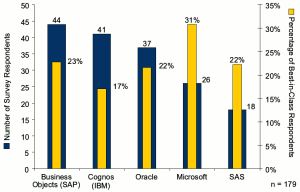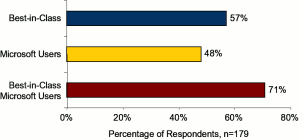
IT and business management are increasingly expressing alarm at rising costs associated with business intelligence (BI) implementations. The fear of hidden costs has kept many companies from making an investment, and many adopters have found that the costs related to ongoing support and maintenance of an ever-changing set of analytical and reporting requirements inhibits user penetration and the ability to manage the total cost of ownership (TCO).
New research conducted among 194 professionals at 162 companies between March and April 2009 reveals that top-performing companies are “doing more with less” when it comes to one of the major costs associated with implementing, deploying and managing a BI solution.
Best-in-Class Winners
Interestingly, despite requiring fewer full-time equivalent employees (FTEs) to support BI deployments, the Best-in-Class are capable of completing BI projects, from start to finish, both on budget and within expected time frames. Additionally, they are delivering BI capabilities to more enterprise users than their counterparts.
This report investigates the key factors that organizations consider important in controlling the total cost of business intelligence implementations. Thirty-seven (37) organizations (20 percent) were found to be Best-in-Class at managing the total cost of ownership (TCO) of their business intelligence solutions. Thirty-one percent of the 26 Microsoft BI users that took part in the survey achieved Best-in-Class status — a higher proportion of its installed base than any other major BI vendor. Figure 1 highlights the number of survey respondents that reported using each vendor’s software, together with the percentage of that vendor’s customers that achieved Best-in-Class.
What Makes Microsoft Stand Apart?
Based on the results of the survey, there are a number of factors that help Microsoft users achieve Best-in-Class performance. There are some clear organizational and behavioral traits and a number of practices around the adoption and use of specific technologies.
- Experience Counts: Like many things in life, the more you do it, the better you get. In this survey, over half of all Microsoft customers (54 percent) had more than five years experience developing and deploying business intelligence projects. That’s a higher proportion than any other major BI vendor. Tellingly, however, if we consider the subset of Microsoft customers that were rated Best-in-Class by Aberdeen, an even greater percentage (63 percent) have over five years BI experience. Experience counts.
- Merciless Pursuit of ROI: Microsoft customers aggressively seek out projects that will provide a rapid return on investment (ROI) — far more so than the customers of some other major BI vendors. Fifty-four percent of Microsoft-using survey respondents identified this as one of their top strategic actions, making it significantly more important than any other action they are undertaking. When we consider Best-in-Class Microsoft users, that gap grows — with 63 percent of customers selecting this as a top strategic action.
- Automate to Drive Out Cost: There are a couple of areas specifically where Microsoft customers rely heavily on key technologies to automate their BI solutions — and hence drive time and cost out of their BI projects.
Microsoft users rely heavily on automated data integration and cleansing to achieve their BI success. Sixty-four percent of Microsoft customers use this class of technology, whereas only 56 percent of all Best-in-Class organizations do. However, this is a “must-have” technology for Microsoft enterprises that achieve Best-in-Class, with 71 percent of those organizations reporting that they currently use it.
The second area of automated capabilities strongly adopted by Microsoft Best-in-Class organizations is the use of automated report generation, as shown in Figure 2.
Other Factors
Although Microsoft BI customers seem to excel at managing the total cost of ownership, users and potential users should also note:
- In general, Microsoft customers fall well short of Best-in-Class standards in the time required to make a change to an existing BI report or view. Eighty-six percent of Best-in-Class organizations report that they can complete such changes in less than one day. Only 50 percent of Microsoft customers can make this claim.
- Microsoft customers also fall well short of Best-in-Class standards in the time required to complete BI projects. Eighty percent of Best-in-Class organizations report that they can complete BI projects in three weeks or less. Just less that half (39 percent) the same number of Microsoft customers report the same level of success.
- Although Microsoft does count large enterprises among its BI customers, smaller organizations dominate among the users that responded to this survey. Thirty-eight percent (38 percent) of Microsoft customers completing this survey have revenues of US US$50 million or less, while only 33 percent have revenues of more than $1 billion. In contrast, large organizations make up at least 43 percent of the customer base of Business Objects (SAP) and Cognos (IBM); more than 50 percent in the case of Oracle and over 60 percent for SAS.
To access the entire report, click here.
David Hatch is vice president and principal analyst of Aberdeen Group’s business intelligence practice. David White is a senior research analyst in the business intelligence practice.
















































